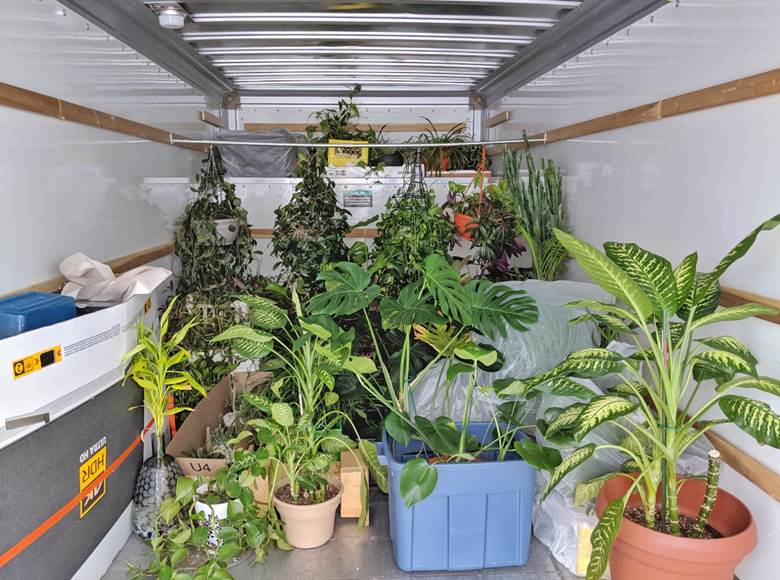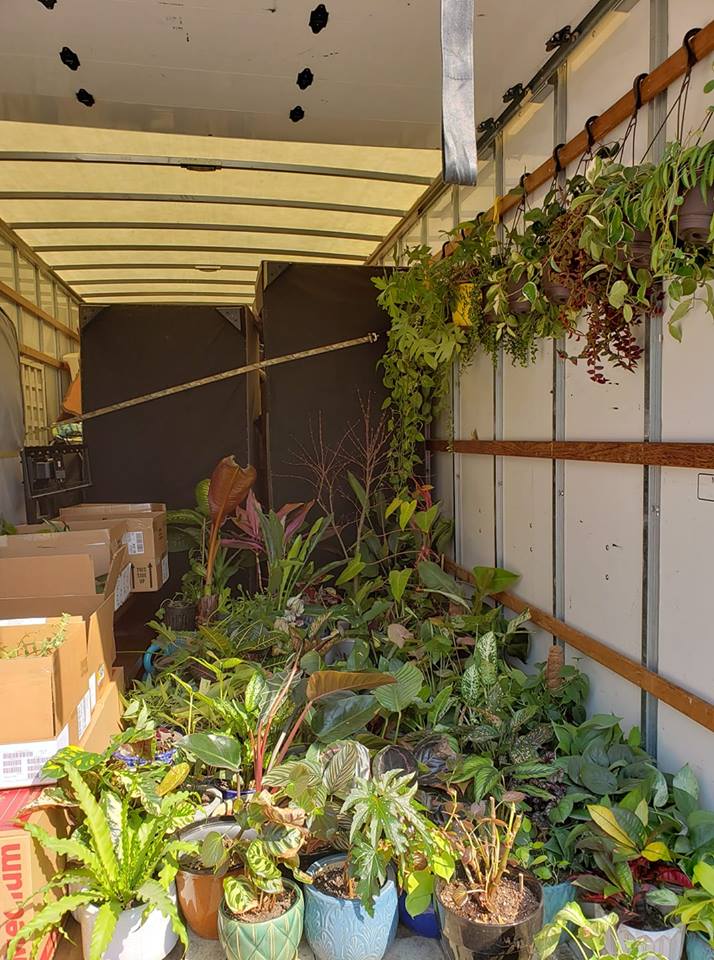So it’s time to move, and you stare lovingly at your beloved indoor house plants and budding outdoor shrubs, wondering how you will successfully transport them to your new home. While not as easy as tossing your clothes and furniture in a truck, plants can make the trek, even if all the way across the country. You just have to prepare.

Checklist For Moving With Plants
Before setting off on your next big adventure in life, take a few extra steps before moving day, to ensure your plants will not only be as healthy as possible, but protected along the journey.
- Remove any dead leaves or branches that may be weakening your plant.
- Water well, without overwatering, the days leading up to your move.
- Transfer from heavy, easily droppable pots, into easier transported plastic pots.
- Tape cardboard over the soil, attaching the tape slack to the pot, to prevent soil spillage (do this right before departure and remove immediately upon arrival).
Along the Way
- Buckle up
You too, but we’re also talking about the plants! Small ones can be wrapped with bubble wrap at their base, and placed in an open cardboard box. Cross the seatbelt over the box, as if you were buckling in a human, and click your bundle of botanical joy into place for a more secure ride.
- Watch the temperature
A lot depends on the plant, but in general, you don’t want most getting too hot, or cold. Best case scenario would be to keep the box of greenery in the front seat, so you can control the optimal environment.
- Water
Depending on the length of the journey, you may end up needing to water the plants. Keep a reusable bottle with you, refilling at rest stops if needed, to keep soil at its optimal hydration level.
Keep in mind: You want to avoid cold/wet, or hot/dry soil—it’s a delicate balance.
Crossing state lines with plants
Believe it or not, there’s some hefty regulations in some states, when it comes to relocating your plants. That’s right, if your caught hauling vegetation and flora, some places may subject items to inspection, quarantine, and may not even allow them in at all. It makes sense though, as it protects the agriculture of each state, especially those that rely heavily on crops. Here’s what you need to know:
- Ask the state’s Department of Agriculture what the guidelines are.
- Sometimes, you’ll just need to change out the soil.
- Look into shipping the plant, as sometimes different rules apply.
- Know that some moving companies completely refuse to deal with plants because of this problem.

Plants That Travel Well
- Bromeliads-Particularly the Puyah variation is quite hardy.
- Aloe-They actually do great in dry soil, and only need to be watered every couple of weeks.
- Jade-This one’s great for gardeners of any skill level.
- Rabbit’s Ears-An adorably fuzzy plant that is more protected against moisture loss.
- Cactus-Self explanatory, but will do great if traversing the hot, dry desert.
- Sansevieria (Ribbon Plant)- These are small and easy to transport.
Plants That Don’t Travel Well
- Ctenanthe—It will die without the perfect light, water and temperature balance.
- Calathea Ornata-This one will not do well traveling in cold, dry conditions.
- Autumn Fern-Too much sun beaming in from your car windows will mean an untimely demise for this woodland plant.
Moving Large Plants
Large plants can be some of the hardest plants to move. Here are a few tips we've learned over the years to help make the move easier.
- Put trash bags around the base to retain soil and moisture.
- Use a plant dolly to transport heavy plants to each location.
- Provide extra support with bungee cords or tree stakes for taller plants that may topple over.
- Get someone to help you lift heavier plants.
Travel With Plant Cuttings Instead
Perhaps your most beloved plant is deeply anchored in the gardens of your back yard, and there’s no way to take the poor little fella with you. Don’t fret. Often, you can snag a stem and re-root it in a pot, to later plant at your new home, just like baby Groot!
- Take a clipping from a healthy, well hydrated part of the specimen
- You can use rooting powder, but it’s not usually necessary.
- Prepare a shallow tray with at least 1 ½ inches of potting soil (If you’ve ever ordered candles from a place like Goose Creek, you’ve likely thought the carboard squares they used for packing are great for this.)
- Poke a small hole in the soil and place the stem in, lightly stabilizing it with soil.
- Keep it moist and out of direct sunlight during your travels.
- After it has established, the entire cardboard square can be planted in your new yard.
If all else fails, you can always gift your beloved plant to someone who appreciates it as much as you do. But we have a feeling you’ll have a successful trans”plant”.
Other Advice From Some Of Our Fans
Here is an update on how my trip across the country with 87 house plants went! A lot of you said you were about to venture on a similar adventure and I would love to share some of my tips, and let you benefit from some mistakes I made. I have a variety of plants some include pothos, monstera, fiddle leaf fig, bird of paradise, snake plants, philodendrons, palms, ferns and banana trees. All plants are alive, some beat up, but living; which was the goal, I think I succeeded which is why I would love to share my process.
1. All of my favorite plants and majority of my smaller plants went inside my suv. Nothing else in the SUV, only plants. It was PACKED.
2. AC running at all times. Stop to get food? Leave car on with ac running. Bathroom break? Leave car running..
3. Covered all of the back windows with paper. You don’t want harsh sun to burn indoor plants.
4. Water all plants 1 day before.
5. For long trailing pothos, fold gently on top of the pot.
6. Fold seats down and line the floor with a tarp or plastic garbage bags.
7. Load the plants as close as possible with blankets or cushion between each pot (so the pots don’t hit each other).
8. Drive through the day and if you have to stop somewhere to sleep, crack windows. And only stop at night. Promptly continue driving before the sun rises! (This is important)
9. The hardest part… my large plants that did not fit in the SUV.
10. We rented and open uhaul trailer.. Not a closed uhaul! Plants will suffocate in a close trailer!
11. We laid down large trees, and stabilized the pots with bungee cords
12. We used two tarps to cover the trailer, the and the top sides, leave back portion open.
13. Key Factor. Poke holes in tarp in the front of the trailer to provide air circulation
Only mistake I wish I could fix would be that the tarp wasn’t tight enough and my palms got a little beat up. They will recover but it could have been prevented.
Also we had a complication on the way which resulted in a 30 minute sit in the sun. Plants in car were fine with AC, but plants in trailer struggled as the Kansas sun is very hot.
 |
Author Karyn Wofford - Published 4-9-2025 |
